
Relationship between Learning English as a Foreign Language and the Executive Attention Profile in Spanish Schoolchildren
[Relaci├│n entre el aprendizaje del ingl├ęs como lengua extranjera y el perfil ejecutivo atencional en escolares espa├▒oles]
Marta Martínez-Vicente1, Vanesa Martínez-Valderrey2, José M. Suárez-Riveiro3, and Carlos Valiente-Barroso4
1Universidad Isabel I, Burgos, Spain; 2Universidad de Valladolid, Spain; 3Universidad Nacional de Educaci├│n a Distancia (UNED), Spain; 4Universidad Villanueva, Madrid, Spain
https://doi.org/10.5093/psed2023a10
Received 7 April 2021, Accepted 19 January 2023
Abstract
Executive functions are established as vital in learning, as well as in the development of psycholinguistic skills crucial to learning a second language. The present study analyzes relationships between variables linked to executive functioning and to academic achievement in English as a foreign language (EFL). The participants were 519 primary school students between the ages of 10 and 12. The results show a tendency to greater sustained and selective attention and consequently better attention control and concentration on task when academic achievement in English was higher. Our discriminant analysis verifies that sustained and selective attention, attention deficit, and concentration on task explain and predict group membership in EFL achievement groups (low, medium, and high achievement). It is important to plan activities to develop executive functioning, alongside the regular curriculum content, in order to improve learning and acquisition of psycholinguistic skills, the foundation for bilingualism or second-language learning.
Resumen
Se constata la importancia de las funciones ejecutivas en el aprendizaje, así como en el desarrollo de habilidades psicolingüísticas cruciales para aprender un segundo idioma. En este estudio se analizan las relaciones entre variables vinculadas al funcionamiento ejecutivo y al rendimiento académico en lengua inglesa. Participaron 519 estudiantes de primaria de edades comprendidas entre 10 y 12 años. Los resultados evidencian la tendencia a una mayor atención sostenida y selectiva y en consecuencia un mejor control atencional y de concentración en la tarea cuando es mayor el rendimiento académico en lengua inglesa; el análisis discriminante efectuado verifica el carácter explicativo y predictivo de la atención sostenida y selectiva, el déficit atencional y la concentración en la tarea en la pertenencia de cada estudiante a los grupos (bajo, medio y alto) de rendimiento en dicha asignatura. Se constata la importancia de programar actuaciones para el desarrollo del funcionamiento ejecutivo en paralelo a las propiamente curriculares, para mejorar el aprendizaje y la adquisición de habilidades psicolingüísticas, base del bilingüismo o del aprendizaje de un segundo idioma.
Palabras clave
Funciones ejecutivas, Lengua inglesa, Rendimiento acad├ęmico, AprendizajeKeywords
Executive functions, English language, Academic perfomance, LearningCite this article as: Martínez-Vicente, M., Martínez-Valderrey, V., Suárez-Riveiro, J. M., & Valiente-Barroso, C. (2023). Relationship between Learning English as a Foreign Language and the Executive Attention Profile in Spanish Schoolchildren. Psicolog├şa Educativa, 29(2), 159 - 166. https://doi.org/10.5093/psed2023a10
Correspondence: mmartinezv11@educantabria.es; marta.martinez.vicente@ui1.es (M. Mart├şnez-Vicente).English has become established as the most widely used language worldwide, and forms part of the educational curriculum in many institutions. The classroom has thus become the main learning space where conditions must be met for the student to communicate in this language. Here, as in other academic subjects, students have taken on an active role in their own learning, implying greater initiative and responsibility in the development of their own skills in the language in question (Beltrán, 2017; Luna et al., 2014). In Spain, since the General Education Act of 1970, the subject of English as a Foreign Language (EFL) has become more and more important in the school curriculum, becoming the first foreign language to be included as a subject in the core curriculum, as is reflected in current legislation. Regarding language immersion, more and more bilingual programs are being implemented in recent years, turning English into an instrument for learning more than merely being another academic subject (Valero & Jiménez-Fernández, 2015). Within the pedagogical context, bilingualism is considered to be a vehicle for learning, through an educational system where the student is instructed for a certain period of time in two different languages, one of them being the student’s first language or mother tongue (Fishman, 1976 as cited in Castro-Castiblanco & Zuluaga-Valencia, 2019). Learning is a complex process, and more so when dealing with a language different from one’s mother tongue; different environmental and individual factors are involved, and even teacher-related factors. Attempts are made to understand whether this acquisition process is conscious or unconscious and thus offer an explanation as to why there are different levels of second language acquisition, either simultaneously or after the mother tongue acquisition. Among the many individual factors, we underscore brain plasticity, which depends on age and is favorable to acquiring new learning. The period of formal operations has been established as the most fruitful for language learning (Díez, 2010; Roca & Manchón, 2006). This period described by Piaget corresponds to the period that Portellano (2018) presents for the evolution and development of executive functions, and ranges from 12 to 20 years. The ability to plan is involved, and levels of prospective memory that are close to adulthood; these take advantage of inner language to develop and consolidate the rest of the executive functions (Portellano & García, 2014; Vega, 2020). Hence, recent years have seen growing interest in the study of learning in conjunction with the development of executive functions, due to the interrelation between the two processes (Flores-Lázaro et al., 2014; Gutiérrez & Solís, 2011; Korzeniowski, 2011; Rojas-Barahona, 2017). Developmentally sensitive periods (approximately between birth and puberty) are closely related to the learning of a second language; when the latter comes late, it requires more effort, possibly with decreased motivation due to negative experiences and lower effectiveness (Janciauskas & Chang, 2017). Nonetheless, we must recall the richness of brain and nervous system plasticity; in the case of students it favors bilingual learning, thanks to the increase in neuronal connections (Fandiño-Parra et al., 2012). Among the individual factors that interfere with learning a second language are learning difficulties associated with the complexity of vocabulary acquisition, or problems with visual and auditory processing, organization of new information, low memorization ability, and attention deficit (García & Tyler, 2010; Van Mensel & Garland, 2022). Among the causes of low academic achievement or low school grades in English are lack of motivation, uninterest in the subject, inattention in class, minimal effort in completing assignments, or extreme immaturity observed in certain students, where difficulties in the mother tongue are extrapolated to second-language learning (Valero & Jiménez-Fernández, 2015). Executive functions make up a complex construct of higher cognitive abilities and metacognitive skills that together participate in the regulation of thoughts, emotions, and behaviors to solve problems and meet one’s goals (Diamond, 2013; Diamond & Ling, 2016). They direct behavior towards a specific end (Flores-Lázaro et al., 2014) and make flexible, self-regulated, creative, effective, and socially accepted behaviors possible, adapted to environmental changes (Korzeniowski & Ison, 2019; Piñón et al., 2019). There are multiple models that explain the components of executive functions. One of these, a frame of reference for many studies in children and adolescents, separates three components corresponding to working memory, response inhibition, and cognitive flexibility (Tirapu-Ustárroz et al., 2018). Others, like the one proposed by Diamond (2013), consider other components of executive functions, such as planning and organization, working memory, cognitive flexibility, and inhibitory, emotional, and attentional control. Although all the theoretical models contribute knowledge to support our understanding of cognitive-executive functioning in a clinical population, such as attention deficit hyperactivity disorder (ADHD), if we integrate the results of the evaluative process into a solid, comprehensive framework of neurocognitive functioning, these can be extrapolated to the entire child population, with or without executive dysfunctions (Mahone & Denckla, 2017; Tirapu-Ustárroz et al., 2018; Villanueva-Bonilla & Ríos-Gallardo, 2018). This explains, for example, how inattention is associated with certain difficulties in working memory, planning, and cognitive flexibility (García et al., 2014), and how these can then influence learning in general and the tasks involved, such as time management, organization of information, or performance monitoring, all included in executive functions (Meltzer, 2014). The importance of these functions in cognitive, social, and emotional development is thus confirmed and, consequently, their ability to predict better academic achievement in students in any stage of education (Berthelsen et al., 2017; Checa & Rueda, 2011; García-Madruga et al., 2014; Korzeniowski. et al, 2016). If bilingualism is considered to affect non-verbal cognitive development, a model must be developed that includes linguistic and non-linguistic functions, that incorporates the executive functions given the limitations of representation processes and working memory as responsible for planning, selective attention, and inhibitory control (Jylkkä et al., 2018; Martínez & Henao, 2006). The impact of bilingualism on students’ cognitive development has been demonstrated; this impact comes through executive functions (Frolli et al., 2022), specifically through selective attention and inhibitory control (Bialystok, 2001; Martin-Rhee & Bialystok, 2008), allowing both languages of the bilingual person to remain active, while one of them is being processed (Gollan & Kroll, 2001). After analyzing the effects of exposure to bilingualism, the results on development of executive functions become clear – attentional control, phonological awareness, and verbal fluency (Crespón & Carreiras, 2020) – where the amount of time devoted to learning a second language is not particularly important in these effects (Bialystok et al., 2013; Castro-Castiblanco & Zuluaga-Valencia, 2019). There is a directly proportional relationship between the time of exposure to a second language and the cognitive stimulation derived from this process (Bialystok & Barac, 2012). It has been demonstrated that bilingual experiences encourage cognitive control, by promoting intellectual development (Ardila, 2012; Esparza & Belmonte, 2020; Struys et al., 2019), and involve advantages in selective attention, response inhibition, working memory, and learning new words, even if these may be limited to certain aspects of cognition (Warmington et al., 2019). Consequently, faced with possible interference from the first language in learning the second, attentional inhibition and control take on an important role in constant monitoring, as well as in stimulating visual attention, which allows inference of the messages to be transmitted to the students (Calvo & Bialystok, 2014; Cintrón-Valentín & Ellis, 2016). The correlation between bilingualism and executive functions has been demonstrated (Villamizar & Guevara, 2013) as have the effects of the former on development of both cognitive and academic skills, where its impact is greater and more motivation is produced at younger ages (Ardila, 2012; Molina, 2015). Prior studies have demonstrated that one of the greatest effects of bilingualism lies precisely in the selective attentional process, where boys and girls have shown better performance on this type of task (Carrada, 2014), and that executive function performance is directly proportionate to the time of exposure to a second language. The impact of bilingualism on executive functioning, therefore, depends to a greater or lesser degree on exposure to bilingual educational settings (Crespón & Carreiras, 2020; Frolli et al., 2022), which would significantly influence higher thought processes and academic skills (Bialystok, 2015; Bialystok & Barac, 2012; Kroll & Bialystok, 2014; Wong et al., 2016). In summary, in light of the foregoing, and considering that there are still few studies that address executive functions and second language learning, the general aim of the present study was to analyze the relationships between variables linked to executive functioning and to EFL achievement in a sample of students in upper primary education. Significant differences are expected to be found in executive functioning according to the level of academic achievement in EFL (low, medium, or high), and executive functioning variables are expected to show predictive and explanatory capacity on academic achievement in EFL. Participants and Procedure Non-probability sampling of the incidental type. Participating in the study were 519 primary school students between the ages of 10 and 12 years (M = 10.74, SD = 0.66), drawn from nine schools in the autonomous region of Cantabria (Spain). Their sociocultural background was medium. Of these, 272 (52.4 %) were fifth-graders and 247 (47.6 %) were sixth-graders; 53.8 % of the total were boys (n = 279, M = 10.78, SD = 0.66) and 46.2 % were girls (n = 240, M = 10.71, SD = 0.65). Initially, we contacted sixteen schools throughout the region of Cantabria (Spain), requesting a prior interview with the school administration to explain the purpose of the investigation. Nine schools agreed to participate and were asked to collaborate directly in applying the tests in fifth- and sixth-grade classrooms. Written informed consent was requested from families or legal guardians to ensure compliance with security measures of Organic Law 15/1999 on the Protection of Personal Data. Once received, the consent forms were kept on file by the school administration, and the total sample, described above, was thus determined. Only students who turned in signed consent and who attended class on the day of questionnaire application participated in the study, the remainder were excluded (3%). On the day predetermined at each school, tests were applied in each classroom by one of the members of the research team, during one class session, and always in the presence of the group’s regular classroom teacher. The objective of the study was explained to the students, insisting that participation was voluntary and ensuring at all times the anonymity and confidentiality of the data obtained. The Assessment of Attention Deficit with Hyperactivity Disorder (EDAH) (Farré & Narbona, 2013) requires completion by the teachers and was delivered to them with instructions; the completed questionnaires were delivered in turn to the school’s Head of Studies, who kept them until they were collected days later by one of the authors of this investigation, together with students’ final grades in EFL, provided by the specialized EFL teacher. Using all the information collected, a cross-sectional study was designed, using a non-experimental, descriptive, correlational, inferential, and multivariate methodology. Measures Perception of Differences Test (FACES-R; Thurstone & Yela, 2012) This test assesses a subject’s visuo-perceptive and attentional capacity and impulsivity in performing a task. For this study, consideration was given to scores obtained in sustained and selective attention, which are measured from the number of correct answers during the task, and constitute a measure of test effectiveness. Within this test, the Impulsivity Control Index (ICI) is an indicator of the lack of inhibitory control reflecting the subjects’ cognitive style along the impulsive-reflective gradient. Internal consistency of the instrument, measured with Cronbach’s alpha coefficient, yielded a value of .91 for the total sample. D2 Test of Attention (Spanish adaptation by Seisdedos, 2012) This is a multiple-choice test under limited time and assesses selective attention, processing speed, and concentration through a task of discriminating visual stimuli. The following variables are considered in this study: (1) processing speed, which is the total number of responses, measuring the amount of work done and motivation for the task; (2) processing accuracy, which is obtained from the total number of correct answers, and measures the amount of work using pertinent elements; (3) errors of omission, which indicate lack of sustained attention, that is, low capacity for maintaining alertness; (4) errors of commission, a measure of processing accuracy and inhibitory control; (5) attentional control, indicating accuracy in visual search and the quality of one’s action; it is obtained from the sum of commission and omission errors; and, finally, (6) concentration on task. Internal consistency values, measured by Cronbach’s alpha coefficient, are greater than .90. Assessment of Attention Deficit with Hyperactivity Disorder (EDAH; Farré & Narbona, 2013) This test assesses ADHD, the risks of suffering from it, and behavioral disorders that may or may not be concomitant. The test is to be completed by the teacher, after prior observation of the student’s behavior. This 20-item Likert-type scale has responses ranging from 1 to 4 (1 = not at all, 2 = a little, 3 = quite a bit, and 4 = very much) and produces results from four subscales that correspond to hyperactivity/impulsivity, attention deficit, behavior disorders, and hyperactivity-attention deficit. For this study, the four scales were considered. The reliability study of the instrument indicates Cronbach alpha coefficients greater than .90 in all subscales, with a value of .95 for the global scale. Academic Achievement in EFL Academic achievement in EFL was evaluated by the grade given in this area of the curriculum. While this may seem a priori to be a simplistic perspective on measuring achievement, focused on outcomes and not on the learning process, one must take into account that this subject is learned continuously, starting at an early age. In all cases, grades for this subject were provided by the students’ regular classroom teacher, who collected them previously from the specialized EFL teachers. Data Analyses First, variables’ goodness of fit to the normal distribution was estimated using the Kolgomorov-Smirnov test, and the homoscedasticity test. After verifying that most of the variables did meet the normality principle, we opted for parametric statistical tests. Descriptive statistics, Pearson bivariate correlations, and an analysis of variance (ANOVA) were carried out, taking academic achievement in EFL as the independent variable, and variables linked to executive functioning as dependent variables. In order to measure effect size, the partial eta-squared coefficient was used (ηp2), considering a small effect when ηp2 ≥ .01, medium if ηp 2 ≥ .059, and large if ηp2 ≥ .138. On the other hand, post hoc contrasts were performed, applying the Bonferroni correction, with a significance value of .05 in cases where significant between-group differences were documented. Finally, a multivariate discriminant analysis was carried out to study the explanatory and predictive nature of executive functions on EFL academic achievement. For the differential and discriminant analyses, three groups of EFL achievement were established, using the following calculated percentiles: low achievement (percentiles below 33), medium achievement (percentiles between 33 and 67, inclusive) and high achievement (percentiles over 67). All data analyses were performed using SPSS, version 25.0 for Windows. Table 1 Intercorrelations for All Items and Scales and Descriptive Statistics  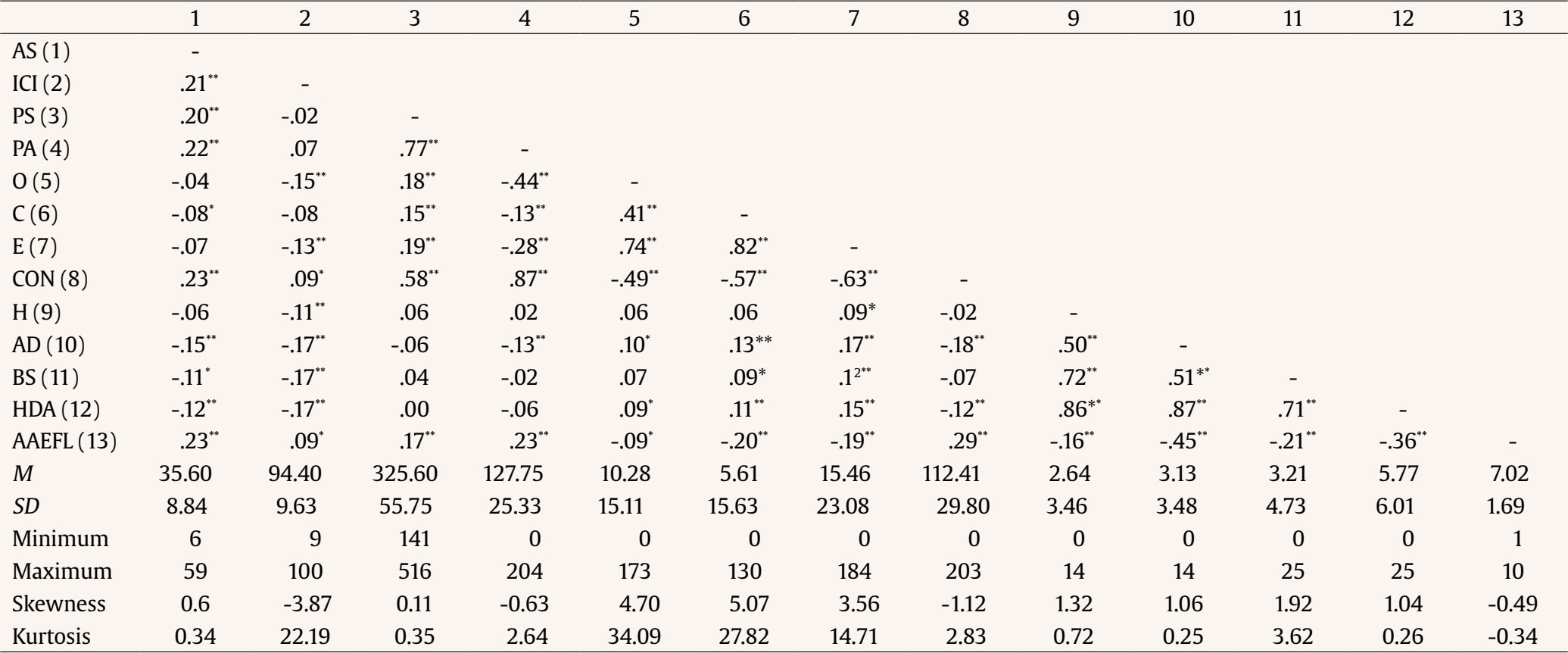 Note. AS: sustained and selective attention; ICI: Impulsivity Control Index; PS: processing speed; PA: processing accuracy; O: errors of omission; C: errors of commission; E: attentional control; CON: concentration; H: hyperactivity/impulsivity; AD: attention deficit; BS: behavior disorders; HDA: hyperactivity/attention deficit; AAEFL: academic achievement in EFL. *p < .05, ** p < .01. Descriptive Analyses and Correlations between EFL Achievement and Executive Function Variables Table 1 presents descriptive statistics and correlations between the different study variables. The results show significant, positive relationships between academic achievement in EFL and sustained and selective attention, the impulsivity control index, processing speed, processing accuracy, and concentration. In addition, there were statistically negative relationships between EFL academic achievement and omissions, commissions, attentional control, hyperactivity/impulsivity, attention deficit, behavioral disorders and hyperactivity-attention deficit. Differences in Executive Functions Depending on Level of EFL Achievement The differences between the variables of executive functioning were studied using ANOVA analysis, taking EFL academic achievement as the independent variable. The univariate analyses between the achievement groups are shown in Table 2, indicating statistically significant differences in all the study variables except omissions. Small effect sizes are observed in impulsivity control index, processing speed, errors of omission, errors of commission, attentional control, hyperactivity/impulsivity, and behavior disorders; a medium effect size in sustained and selective attention, processing accuracy, and concentration; and a large effect size in attention deficit and hyperactivity/attention deficit. Tabla 2 Means (standard deviations) and Analysis of Variance of the Variables as a Function of the Academic Achievement in EFL  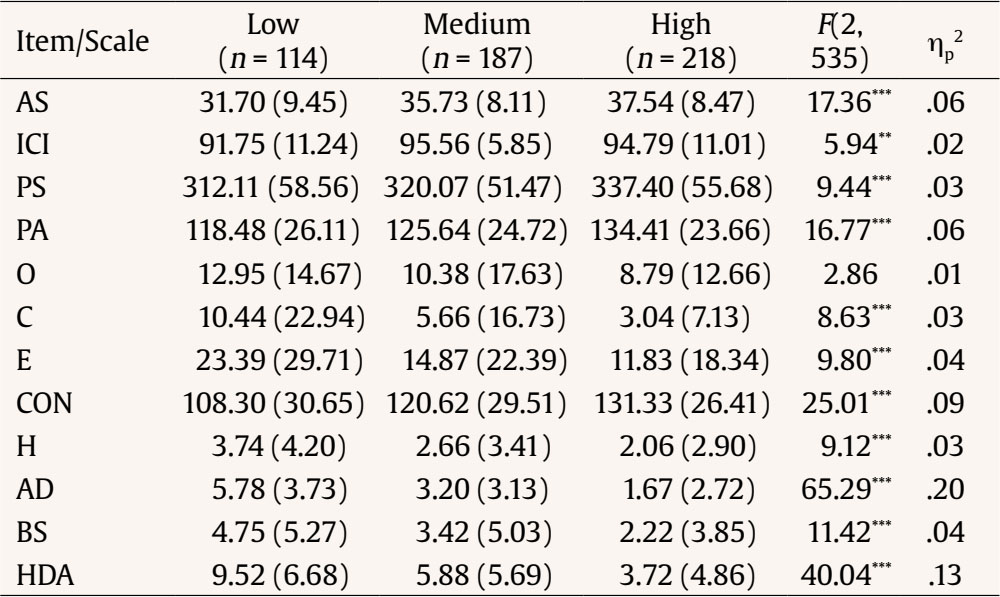 Note. Sustained and selective attention; ICI: Impulsivity Control Index; PS: processing speed; PA: processing accuracy; O: errors of omission; C: errors of commission; E: attentional control; CON: concentration; H: hyperactivity/impulsivity; AD: attention deficit; BS: behavior disorders; HDA: hyperactivity/attention deficit *p < .05, **p < .01, ***p < .001. The Bonferroni post hoc test was applied to learn which pairings of the EFL achievement groups showed significant differences. The results, as seen in Table 3, reflect such differences between the low achievement group and the medium and high groups in all variables, and between the medium and high achievement groups in processing speed, processing accuracy, concentration, attention deficit, behavior disorders, and hyperactivity-attention deficit (Figure 1). Discriminant Analysis Using Executive Function Variables to Predict Membership in the Different EFL Achievement Groups In order to make predictions about the EFL academic achievement groups, a discriminant analysis was carried out, introducing the variables corresponding to executive functions as independent variables. Wilks’ Lambda was calculated, noting the variable measures that present significant differences in the groups defined. The results first allow us to confirm adequate separation between the three groups, classifying them on the basis of two functions. The first canonical discriminant function explains 99.5% of the total variance, indicating good discrimination of the linear function since it presents an eigenvalue of .369 and a canonical correlation of .519 (51.9%), with significant differences found between the EFL academic achievement groups (low, medium and high) (Wilks lambda = .729, χ2 = 162.73, p = .000). The second function explains only 0.5% of the total variance, presenting an eigenvalue of .002 and a low correlation, with no significant between-group differences found in this function (Wilks lambda = .998, χ2 = 1.00, p = .61). In this study, the maximum F significance to be entered was 3.84, and the minimum to be eliminated was 2.71, such that (N = 519) entered as valid cases in the analysis of the total sample. The two functions identified are interpreted in the same way as a factor analysis. The structure matrix shown in Table 4 shows the variables that enter in each discriminant function and the correlations within the groups that combine the variables and the standardized canonical discriminant functions. The variables are ordered within each function according to absolute size, noting the greatest absolute correlation between each variable and any discriminant function. A total of three variables are entered, the rest being eliminated; greater predictive weight of attention deficit can be observed in the group with low EFL academic performance, as is also seen in the variables of sustained and selective attention and concentration in the group with high academic performance. Tabla 4 Structure Matrix  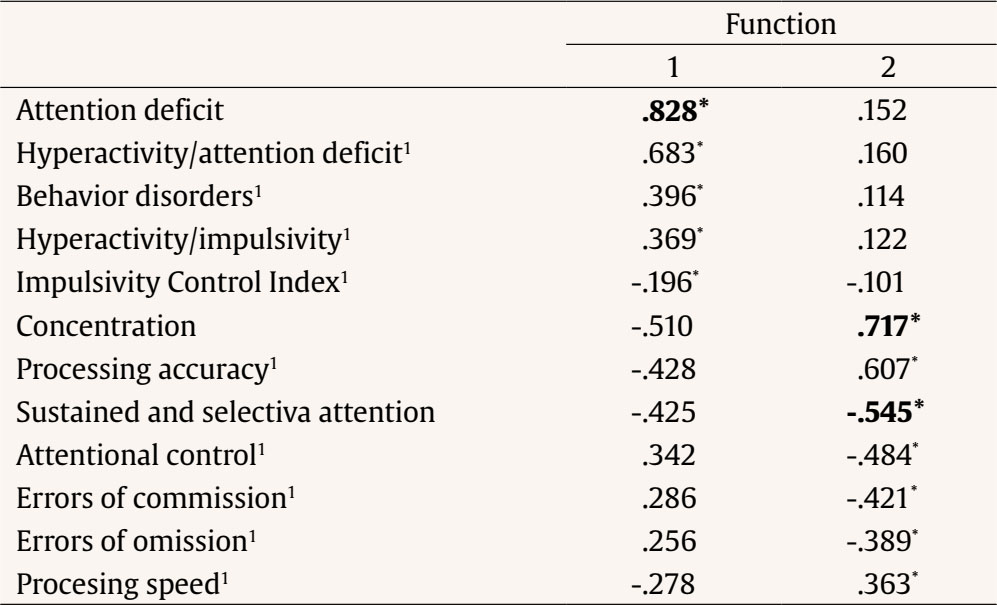 Note. 1This variable is not used in the analysis. *Largest absolute correlation between each variable and any discriminant function. Variables in bold are used in the analysis. Finally, Table 5 presents the results of the classification for identifying group membership, in which 53.9% of the total cases were correctly classified, considering the original groups. In the diagonal of the upper part of the table we can observe the students (n = 280) whose group membership was predicted in agreement with where they actually appear according to their scores in the predictive variables. The lower part shows the percentages of the levels (low, medium, and high) of EFL academic performance, with 43.9% corresponding to the group of students with low EFL performance, and a higher percentage, 79.4% to the group with high performance. The different components that make up executive functions take on an especially relevant role in English language learning, as has also been demonstrated in other academic subjects. Continuing a line of research initiated in earlier studies, the aim of the present study was to analyze and inquire further into the relationship between executive functioning and academic achievement in EFL. The results have confirmed significant direct relationships between achievement in this subject and sustained and selective attention, impulsivity control index, processing speed, processing accuracy, and concentration, as well as inverse relationships between academic achievement in EFL and student errors, both omission and commission, attentional control, hyperactivity/impulsivity, attention deficit, behavior disorder, and the combination hyperactivity/attention deficit. There is a documented tendency, therefore, toward better EFL achievement in students who show greater sustained and selective attention and, consequently, better attentional control and concentration on task. These results reinforce other earlier results reporting that bilingual boys and girls performed better than others in tasks that require high levels of attention and inhibitory control (Frolli et al., 2022), thus confirming the positive influence of bilingualism on executive function (Bialystok, 2001; Crespón & Carreiras, 2020; Martin-Rhee & Bialystok, 2008) and of the latter on academic achievement and learning in general (Bialystok et al., 2013; Castro-Castiblanco & Zuluaga-Valencia, 2019; Meltzer, 2014). By grouping students according to their academic achievement in EFL, those with high levels of achievement have showed better sustained and selective attention, inhibitory control, processing speed and accuracy, attentional control, and concentration than did their low achievement counterparts. The same differences between the two groups were found in errors of omission and commission, hyperactivity, attention deficit, and hyperactivity-attention deficit, where students with poor academic achievement showed higher scores. Evidence from prior studies that explain that bilingual learning favors cognitive development and executive functioning are thus reinforced (Ardila, 2012; Bialystok & Barac, 2012; Esparza & Belmonte, 2020; Gabriel et al., 2017; Struys et al., 2019; Warmington et al., 2019). Finally, the discriminant analysis reinforces the results obtained previously, demonstrating the explanatory and predictive ability of sustained and selective attention, attention deficit, and concentration on task for group membership in the groups of low, medium, and high academic achievement in EFL. All this follows in the line of studies where attention or attentional control, inhibition, or concentration were related to scholastic achievement and learning, even more so when dealing with a second language, and how bilingualism has a positive effect on the development of executive functions (Frolli et al., 2022), for example in attention (selective, visual, and auditory), working memory, and cognitive flexibility within the school context (Ardila, 2012; Bialystok, 2015; Castro-Castiblanco & Zuluaga-Valencia, 2019; Fonseca et al., 2016; Smekal, 2014). These ideas endorse the thesis that learning a second language is very likely to be one of the main causes of intellectual development (Esparza & Belmonte, 2020). As previous studies indicate, students who do not pass the EFL subject may present learning difficulties specific to second language learning, and the specialized EFL teacher must be aware of different student profiles, developing individualized and personalized interventions that are adjusted to the four skills of speaking, listening, reading, and writing, typical of learning any foreign language (Valero & Jiménez-Fernández, 2015). In addition, according to guidelines set by the new neuroeducation philosophy, it would not be misguiding to incorporate executive competence in the classroom as a means to improve academic learning, just as learning to learn or language competence are included in the current Spanish educational curriculum as key competences (Vega, 2020). As for study limitations, we note the typical limitations of non-experimental and cross-sectional design, whereby is not possible to establish causal relationships between the variables or determine their possible mediation in each other. Furthermore, it should be noted that when using self-report instruments, even with proven validity and reliability, they may partially bias the results given the subjectivity implicit in the responses. Conclusions In conclusion, it is hoped that the results of this study will reinforce previous results and support future research where we recommend inclusion of cognitive variables as a criterion in sample selection, in addition to taking into account at what age participants began second-language acquisition – since it is well known that many students attend after-school English classes and go on vacation trips to reinforce their knowledge of English. The study sample should be expanded to include students from different geographical regions and take into account socioeconomic and cultural level; longitudinal studies should be carried forward, addressing secondary education, due to the importance of executive development at these ages. In addition to the study time dedicated to EFL, it is a priority to strengthen programs of learning (Villegas et al., 2016). Taking into account the empirical evidence that shows the correlation between executive functions and bilingualism (Villamizar & Guevara, 2013), it becomes a priority to apply intervention programs in executive functionality alongside the learning of the English language, as is being done in other curriculum areas such as mathematics and mathematical problem solving (Martínez-Vicente & Valiente-Barroso, 2017). In short, these results support the implementation of structured cognitive stimulation programs that especially impact executive function. These programs can be a direct application of neurocognitive proposals that enhance executive functions, or they may work indirectly through resources that optimize executive function and focus more on study habits. Such is the case with interventions that promote inferential, deductive, and inductive ability, logical reasoning, problem solving, and learning strategies, as well as the whole range of processes that make up the more executive-oriented attentional capacity, as is evident in this study. All this is to take place from a learning-to-learn approach, which not only respects cognitive maturation processes – where executive functions are the last stage in human development – but also recognizes the necessary transfer of this cognitive gain, not only for its benefit in our students learning the English language, but also when learning any subject or functional task. Conflict of Interest The authors of this article declare no conflict of interest. Cite this article as: Martínez-Vicente, M., Martínez-Valderrey, V., Suárez-Riveiro, J. M., & Valiente-Barroso, C. (2023). Relationship between learning English as a foreign language and the executive attention profile in Spanish schoolchildren. Psicología Educativa, 29(2), 159-166. https://doi.org/10.5093/psed2023a10 References |
Cite this article as: Martínez-Vicente, M., Martínez-Valderrey, V., Suárez-Riveiro, J. M., & Valiente-Barroso, C. (2023). Relationship between Learning English as a Foreign Language and the Executive Attention Profile in Spanish Schoolchildren. Psicolog├şa Educativa, 29(2), 159 - 166. https://doi.org/10.5093/psed2023a10
Correspondence: mmartinezv11@educantabria.es; marta.martinez.vicente@ui1.es (M. Mart├şnez-Vicente).Copyright © 2026. Colegio Oficial de la Psicología de Madrid


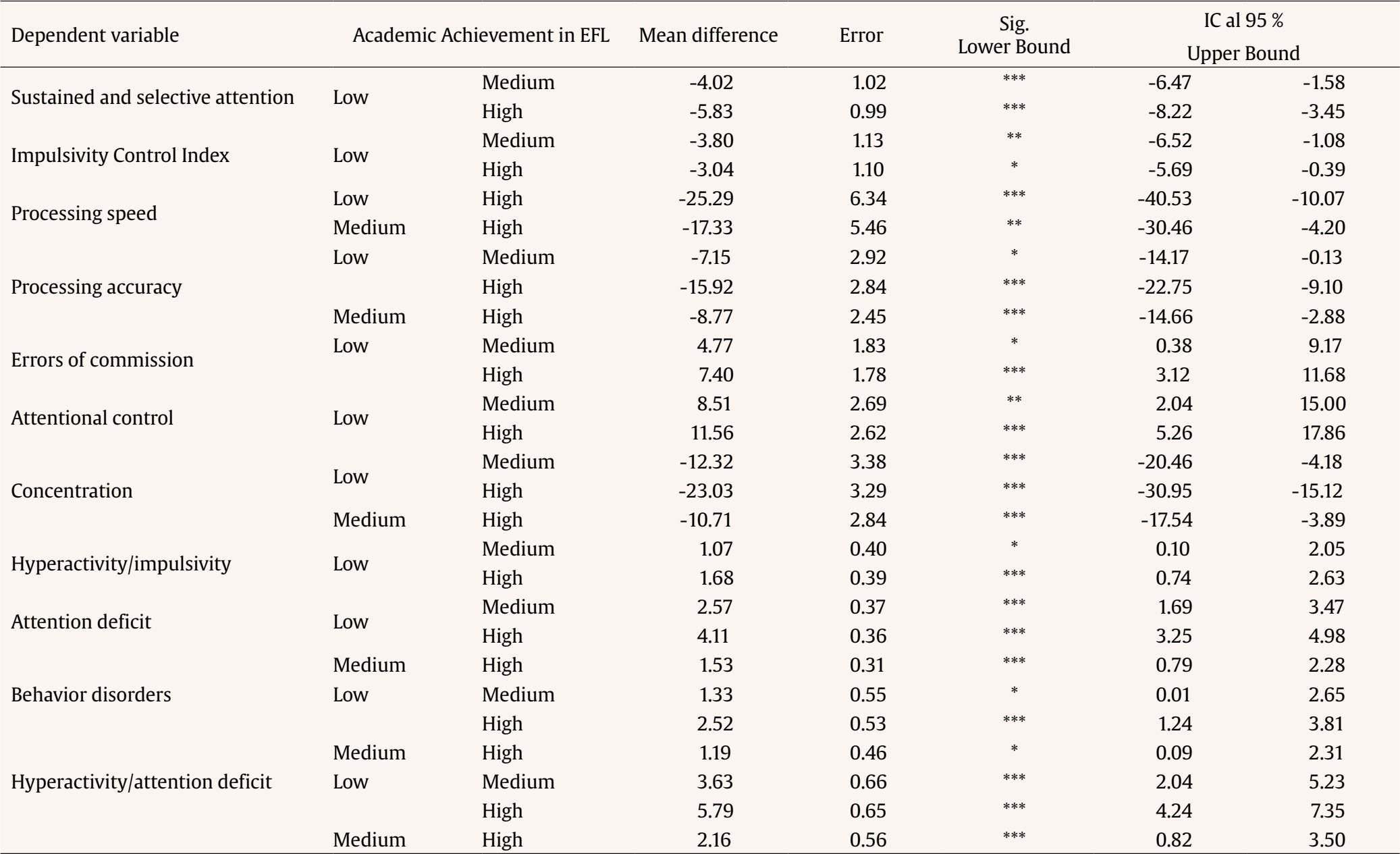
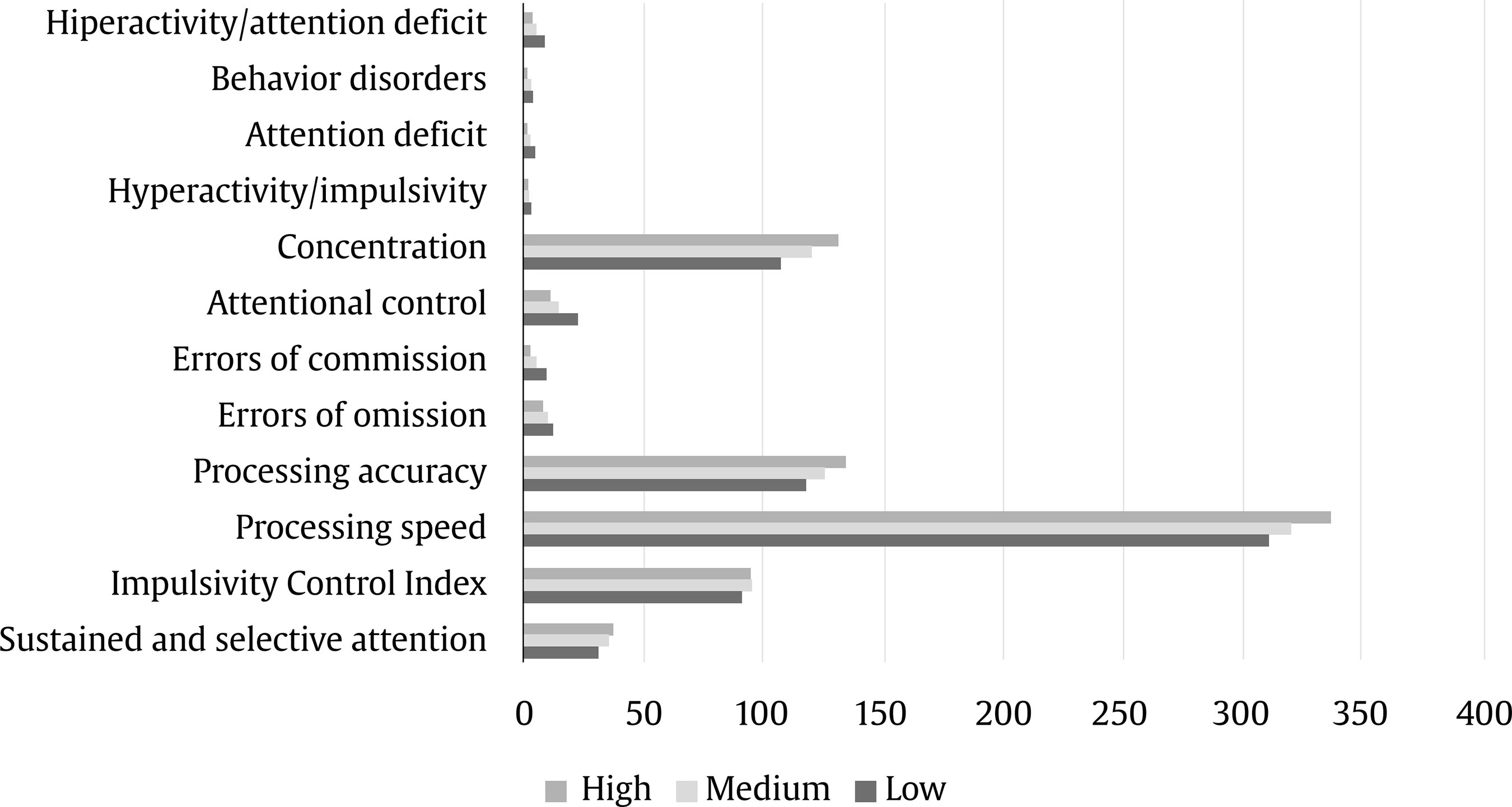
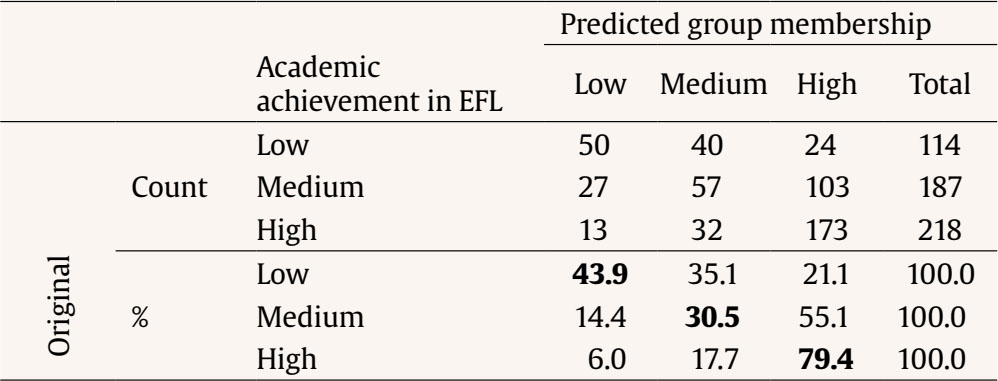






 e-PUB
e-PUB CrossRef
CrossRef JATS
JATS








